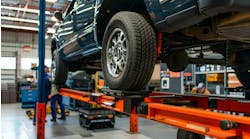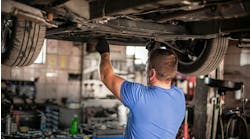With as many miles as commercial vehicles cover in a day, it’s no surprise that winter can be a tricky period for fleets, whether that means managing increased tire deflation or emergency roadside events. But while maintenance departments are well aware of how to prepare for winter maintenance, it can still be difficult to clear snow and ice from the most inaccessible areas on a vehicle.
This is where snow removal machine such as Scraper Systems FleetPlow come in. The automated system clears snow and ice from the top of several commercial vehicles, including dry vans, reefer trailers, intermodal containers, box trucks, and buses, with model options to match both medium- and heavy-duty trucks.
The FleetPlow line turns 25 this year, with 1,500 units in operation. The first unit is still going strong as well. That FleetPlow began service Jan. 1, 1998 at a Yellow Freight terminal in Fishkill, New York. The terminal manager there first developed the product to assist his own crew, which would take days to manually remove snow after heavy winter storms.
That accumulation can also stress the roofs of commercial vehicles and trailers.
“Just 6 inches of heavy, wet snow atop a 53-inch trailer can weigh 5,000 lb.,” said Fin Livingston, general manager of FleetPlow. “Slushy snow can weigh twice as much. Under significant snow weights, trailer rooftop frames can bend and whole rooftops can collapse, rendering the trailers un-useable and in need of repair.”
With trailers themselves bowing under the weight of winter weather, it’s understandable that fleets might struggle if only equipped with truck brushes or snow rakes. Yet the consequences of inadequate clearing are even worse, especially as rooftop snow and ice begins to melt and slide whenever a vehicle hits the brakes.
“Snow and ice when sliding forward can fall on the air and or hydraulic lines between the rig and the trailer, breaking those off [and] potentially disabling the brakes on the trailer,” Livingston explained. “Heavy, wet snow and ice could also scrape paint and cause body damage as it falls onto the cab. Likewise, snow and ice that slides forward onto the roof and windshield of a cab could startle the driver, disrupt their vision, and cause crashes.”
Beyond snow and ice’s danger to those driving an uncleared vehicle, they’re just as threatening to those around it. Winter debris that dislodges from commercial vehicles can become missiles in midair, blocking the vision of vehicles following behind.
“Even worse, snow launching from truck and trailer roofs can result in life-changing or life-ending tragedies that no person or company wants to occur,” Livingston warned.
Some incidents such as these have caused snow removal to be increasingly mandated by several U.S. states and Canadian provinces. Among these include Jessica’s Law in New Hampshire, which was enacted in 2001 after Jessica Smith was killed in a collision with a snow-blinded vehicle due to snow from a large truck. Fines can reach $500 for a first offense and $1,000 for repeat offenses.
Another is Christine’s Law, which was passed just last year in Pennsylvania. Once again, these legislators enacted the law following a tragic incident when a piece of ice dislodged from a passing box truck and crashed through the windshield of Christine Lambert’s vehicle, killing her as she drove with her husband and son.
Such laws enact their own toll even if a vehicle’s rooftop snow does not result in tragedy. In New Hampshire, snow-specific laws can levy $250-$1,000 fines for vehicles found out of compliance, while in Pennsylvania, fines can range even higher from $50-$1,500. In both states, U.S. Federal Vehicle laws and State Snow laws contribute to these fines, but even without such legislation, fleet operators can’t ignore their snow-removal responsibility.
“Federal laws in the U.S. and provincial laws in Canada prohibit unsecured and overweight loads that impact commercial vehicles,” Livingston explained. “Some U.S. states add stricter laws to govern load security and weight, over and above federal regulations.”






